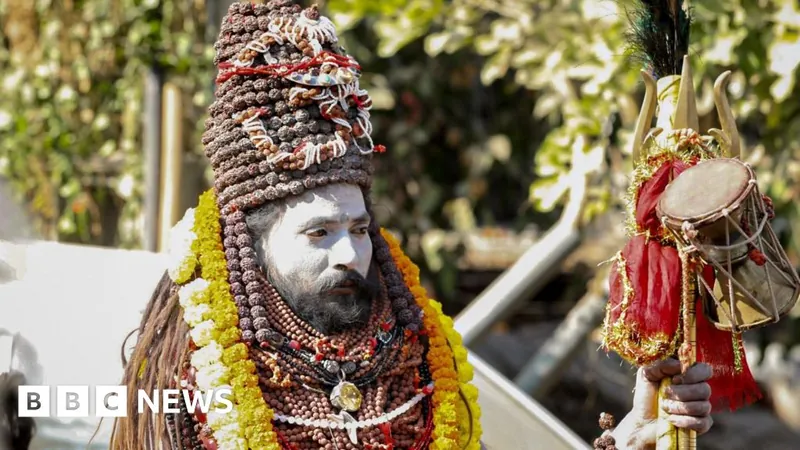
Divine Gatherings: India’s Kumbh Mela Unfolds with Majestic Rituals
2025-01-14
Author: Lok
Breathtaking Spectacle at Dawn
In a breathtaking spectacle at dawn, ash-smeared Hindu ascetics charged into the sacred waters of the Ganges River in Prayagraj, marking the first major bathing day of the Kumbh Mela festival — a gigantic religious gathering that asserts its significance not only in India but across the globe. Known as the Mahakumbh, this extraordinary event epitomizes the convergence of spirituality and tradition, drawing millions eager to cleanse their souls.
The Naga Sadhus and Their Rituals
The Naga sadhus, or naked holy men, initiated the ritual by immersing themselves in the icy waters, invoking Hindu deities with fervent chants. After emerging from the river, they adorned themselves with fistfuls of sacred silver sand, signifying a connection to both the earth and the divine. With tridents and swords in hand, some ascetics held aloft symbolic representations, including ornate silver staffs crowned with snake-heads, showcasing their unique spiritual identities.
A Grand Turnout Expected
As day one of this year's festival saw roughly 16.5 million devotees participating, officials predicted an even grander turnout for Tuesday’s Shahi Snan, or "royal bath." By the end of the 45-day event, authorities expect over 400 million attendees, a stunning testament to the Kumbh Mela's stature as the world’s largest peaceful gathering, visible even from space.
Managing the Colossal Crowds
Yet, the festival's magnitude presents challenges. Police faced difficulties managing the colossal crowds. Reports from Mahant Prayag Puri Ji of Juna Akhara highlighted concerns regarding safety, with the holy man stating that conditions grew disorderly as participants scrambled for a place at the sacred confluence.
Shahi Snan Rituals
Shahi Snan rituals see groups of ascetics arriving in vibrant, processional colors at the Sangam, the confluence site of the Ganges, Yamuna, and the mythical Saraswati rivers. For many pilgrims, the mere presence of these revered figures imbues the river’s waters with extraordinary purity, enhancing the spiritual significance of their ritualistic baths. Astrologers determine the auspicious bathing days, carefully calculated based on celestial alignments, marking important times for devotees.
Key Bathing Days
This year, key bathing days include January 14, January 29, and February 3, with the latter day expected to draw between 50 to 60 million worshippers—the largest gathering forecasted. To accommodate pilgrims, authorities have erected an expansive tented city spanning over 4,000 hectares along the riverbank.
Festival's Ancient Origins
The festival's origins can be traced to ancient mythology involving a battle between gods and demons for a Kumbh (pitcher) of nectar. Droplets spilled as the two factions fought, landing in four locations—Prayagraj, Haridwar, Ujjain, and Nashik—where Kumbh Mela celebrations are now held every 12 years.
Unique Planetary Alignments
Mahant Ravindra Puri emphasized the unique planetary alignments this year, suggesting that they lend a "Maha" quality, or greatness, to the festival, amplifying its spiritual potency. He, along with thousands of other holy men, joined together in prayer, expressing their belief that the river's waters become imbued with divine nectar during this sacred time.
Participation of Ordinary Pilgrims
Amongst the throngs of saints, ordinary pilgrims eagerly partake in the festivities. Chitiya Ahirvar, a 60-year-old woman from Madhya Pradesh, expressed her devotion after praying for her children's well-being in the Ganges. Similarly, Mavaram Patel from Tamil Nadu, relishing his first visit to the Kumbh Mela, expressed gratitude for this opportunity to continue a journey steeped in ancient tradition.
A Captivating Blend of Culture and Faith
As the Kumbh Mela unfolds, the atmosphere buzzes with the sounds of drumming, chanting, and spiritual discourses, creating a captivating blend of culture and faith that not only highlights Hinduism’s rich heritage but also reinforces its ideals of community, reverence, and the pursuit of inner peace. Don't miss the spectacle—witness how faith inspires millions to come together for a cause greater than themselves!


 Brasil (PT)
Brasil (PT)
 Canada (EN)
Canada (EN)
 Chile (ES)
Chile (ES)
 Česko (CS)
Česko (CS)
 대한민국 (KO)
대한민국 (KO)
 España (ES)
España (ES)
 France (FR)
France (FR)
 Hong Kong (EN)
Hong Kong (EN)
 Italia (IT)
Italia (IT)
 日本 (JA)
日本 (JA)
 Magyarország (HU)
Magyarország (HU)
 Norge (NO)
Norge (NO)
 Polska (PL)
Polska (PL)
 Schweiz (DE)
Schweiz (DE)
 Singapore (EN)
Singapore (EN)
 Sverige (SV)
Sverige (SV)
 Suomi (FI)
Suomi (FI)
 Türkiye (TR)
Türkiye (TR)
 الإمارات العربية المتحدة (AR)
الإمارات العربية المتحدة (AR)